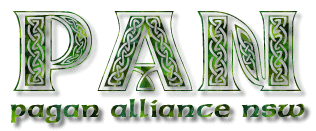|
Lughnasadh 2001 Newsletter About Lughnasadh |

|
Lughnasadh is usually celebrated in the Southern Hemisphere between the 31st January and the 2nd of February. In the Northern Hemisphere it is celebrated on August the 2nd. Some Australian traditions still celebrate the festivals according to the northern dates, and other change the festivals to fit in with our Australian conditions. There are various schools of thought regarding the positioning of the Sabbats in relation to the seasons in Australia and a couple of good books that raise this issue include The Witches of Oz (Julia and Mathew Philips) and Sunwyse (Roxanne Bodsworth).
Lughnasadh is pronounced loo-nus-uh and is associated with the Irish God Lugh. Lugh is described as being either the King or the champion of the Irish Tuatha de Dannan. For a wonderful account of these people and the stories associated with them, it is well worth reading Early Irish Myths and Sagas (edited by Gantz), or for a modern translation of The Tain by Thomas Kinsella - this story contains many tales of the deeds of Cuhulain (the hound of Ulster).
This festival is also harvest festival, where in days gone by people, and families would gather together to play games, race horses, and feast in celebration of the harvest. It was not until medieval times that Lughnasadh also became known as Lammas (meaning 'loaf mass'). This came from the Christian tradition of offering bread made from harvest grains, to their god. Have you ever grown your own wheat? Or your own vegetables that you hope to harvest to stock your kitchen?
Traditional activities at this time of year include placing a selection of your harvest on your altar, or in your outdoor sacred space, as an offering of thanks. Think about what you have gathered in your life and place symbols of these also on your altar along side your plant harvests. It might be a vegetable you have grown, or an artwork that you have created using symbols to represent the offering. What has the harvest bought into your life?
To celebrate the abundance of the earth, and to share it with others can be done by the organisation of a feast to celebrate the changing seasons. You can also share this sprit by donating some food to charity so that others can share in the abundance the Earth has to offer. Tin food drives can be conducted at home, work, your street, child care centre etc, and are not limited to donating just before December 25th!
A traditional activity is also the weaving of corn dollies. The material for weaving these can be purchased from florists, or craft stores. This is a great activity to get the kids involved in, and your local library should have books on wheat and corn weaving in the folk art craft section. If you grow your own wheat or corn have you tried to make corn dollies?
Another way that has been suggested to me as a way of connecting with the arts and crafts of our ancestors, might be to visit a local craft show, or agricultural show. Have a look at what our county areas are producing. You may even be able to learn from the experts how to produce a particular type of craft item. The Royal Easter Show is coming up in April in Sydney, and the highlight is always the agricultural section. Do you know what fruit and vegetables would be in season at that time of the year?
We will now also notice the days getting shorter, as we witness the descent of the Sun into the underworld. Here it will wait to be reborn at the Winter Solstice. The days however still have plenty of heat in them. They warm the earth to sustain it through the long winter months. Autumn now stands in front of us, can you see the leaves changing colour yet?
![]()